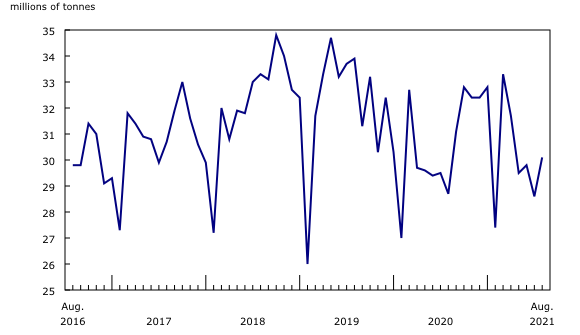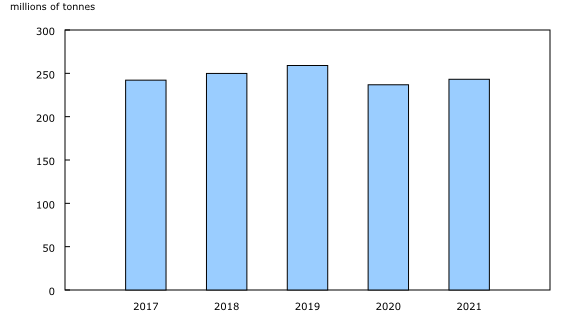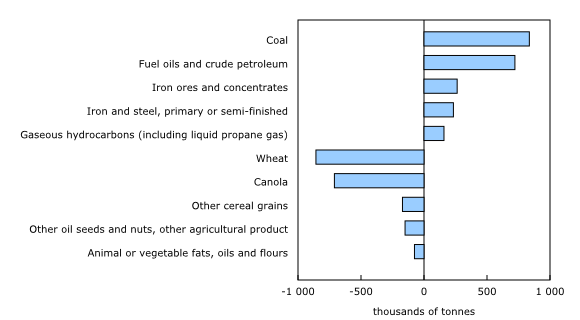Railway carloadings, August 2021
Archived Content
Information identified as archived is provided for reference, research or recordkeeping purposes. It is not subject to the Government of Canada Web Standards and has not been altered or updated since it was archived. Please "contact us" to request a format other than those available.
Released: 2021-10-25
30.1 million metric tonnes
August 2021
4.7% 
(12-month change)
Highlights
In August, Canadian railways transported 30.1 million tonnes of freight, up 4.7% from August 2020. Higher shipments of energy products helped year-over-year growth resume following a decline in July (-3.1%).
While August saw the third highest year-over-year growth in tonnage this year, the total freight traffic was just below the five-year average of 31.3 million tonnes for the month.
To further explore current and historical data in an interactive format, please visit the Monthly Railway Carloadings: Interactive Dashboard.
Cumulative tonnage below pre-pandemic levels
On a year-to-date basis through August, the volume of goods moved by rail totalled 243.1 million tonnes. While this total was 2.7% above the same January-to-August period last year, it was 6.1% below the cumulative total reported for the same period in 2019, prior to the pandemic.
Energy products up sharply
Following three straight months of year-over-year declines, non-intermodal freight loadings in Canada increased by 2.0% to 23.4 million tonnes in August, led by large increases in some hydrocarbon-based commodities.
With further easing of COVID-19-related restrictions, along with increasing fuel consumption and industrial production, global demand for energy products has been rising. For example, loadings of coal saw a sharp increase of 32.9% (+836 000 tonnes) in August from the same month a year ago, reflecting a strong demand for industrial energy in Asia—notably in China.
After posting year-over-year declines for more than a year, loadings of fuel oils and crude petroleum have now increased for a fourth straight month in August. The 115.2% increase (+721 000 tonnes) from August 2020 followed substantial year-over-year growth in July (70.8%) and June (91.6%).
In addition, loadings of gaseous hydrocarbons (including liquid propane gas) grew 31.9% (+158 000 tonnes) from August 2020, following large increases in July (23.8%) and June (28.2%). According to August data on Canadian international merchandise trade, exports of energy products rose sharply (+81.1%) year over year to their highest value since March 2014.
After three monthly year-over-year declines due to temporary disruptions, loadings of iron ores and concentrates—feedstock for the production of steel—picked up again in August, rising 5.5% (+263 000 tonnes). With post-COVID stimulus packages focused on infrastructure and construction, loadings of iron and steel, primary or semi-finished, posted a strong increase of 111.5% (+233 000 tonnes) from the same month a year earlier—marking the seventh consecutive increase. As previously reported by Statistics Canada, manufacturing sales by the primary metal industry were up 55.2% year over year in August.
Grains continue to slide
Growth in freight traffic was moderated by ongoing declines in loadings of some agricultural and food products. In particular, wheat loadings—on a downward trend since May 2021—fell 38.6% (-858 000 tonnes) year over year in August, marking the fourth consecutive decline.
Similarly, loadings of canola have declined year over year for six straight months, dropping by 83.9% (-711 000 tonnes) in August, following large declines in July (-58.1%) and June (-32.7%). Loadings of other cereal grains fell 39.8% (-171 000 tonnes) year over year in August, a third consecutive month of decline.
This decrease in loadings of grain may reflect, among other factors, the depletion of grain stocks after months of strong demand for Canadian-grown grains throughout 2020, as well as lower crop production due to this summer's drought across the Prairies.
Loadings of other oil seeds and nuts and other agricultural products dropped by 78.2% (-150 000 tonnes) year over year, the fifth consecutive month of declines, while animal or vegetable fats, oils and flours were down 19.0% (-76 000 tonnes) in August.
Domestic intermodal up again
Following a decline in July due partly to the mainline disruptions caused by wildfires in British Columbia, intermodal shipments—mainly containers—originating in Canada were up 18.0% year over year to 3.2 million tonnes in August. This was the third highest monthly volume on record and the 11th consecutive month of year-over-year increases.
August growth reflects higher international demand for Canadian consumer goods. According to August data on Canadian international merchandise trade, Canada's exports of consumer goods reported a year-over-year increase of 11.1%.
American freight remains up
Freight loadings arriving from the United States saw a year-over-year increase for the sixth straight month, up 13.3% to 3.5 million tonnes in August.
Note to readers
The Monthly Railway Carloadings Survey collects data on the number of rail cars, tonnage, units and 20-feet equivalent units from railway transporters operating in Canada that provide for-hire freight services.
Cargo loadings from Armstrong, Ontario, to the Atlantic coast are classified to the eastern division (eastern Canada), while loadings from Thunder Bay, Ontario, to the Pacific coast are classified to the western division (western Canada).
Survey data are revised on a monthly basis to reflect new information.
The data in this release are not seasonally adjusted.
The Transportation Data and Information Hub, a web portal developed jointly by Statistics Canada and Transport Canada, provides Canadians with online access to comprehensive statistics and measures on the country's transportation sector.
Contact information
For more information, or to enquire about the concepts, methods or data quality of this release, contact us (toll-free 1-800-263-1136; 514-283-8300; STATCAN.infostats-infostats.STATCAN@canada.ca) or Media Relations (613-951-4636; STATCAN.mediahotline-ligneinfomedias.STATCAN@canada.ca).
- Date modified:




